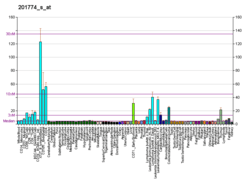NCAPD2
Condensin complex subunit 1 also known as chromosome-associated protein D2 (CAP-D2) or non-SMC condensin I complex subunit D2 (NCAPD2) or XCAP-D2 homolog is a protein that in humans is encoded by the NCAPD2 gene.[5][6][7] CAP-D2 is a subunit of condensin I, a large protein complex involved in chromosome condensation.
References
- GRCh38: Ensembl release 89: ENSG00000010292 - Ensembl, May 2017
- GRCm38: Ensembl release 89: ENSMUSG00000038252 - Ensembl, May 2017
- "Human PubMed Reference:". National Center for Biotechnology Information, U.S. National Library of Medicine.
- "Mouse PubMed Reference:". National Center for Biotechnology Information, U.S. National Library of Medicine.
- Nagase T, Seki N, Tanaka A, Ishikawa K, Nomura N (Mar 1996). "Prediction of the coding sequences of unidentified human genes. IV. The coding sequences of 40 new genes (KIAA0121-KIAA0160) deduced by analysis of cDNA clones from human cell line KG-1". DNA Res. 2 (4): 167–74, 199–210. doi:10.1093/dnares/2.4.167. PMID 8590280.
- Schmiesing JA, Gregson HC, Zhou S, Yokomori K (Sep 2000). "A human condensin complex containing hCAP-C-hCAP-E and CNAP1, a homolog of Xenopus XCAP-D2, colocalizes with phosphorylated histone H3 during the early stage of mitotic chromosome condensation". Mol Cell Biol. 20 (18): 6996–7006. doi:10.1128/MCB.20.18.6996-7006.2000. PMC 88774. PMID 10958694.
- "Entrez Gene: NCAPD2 non-SMC condensin I complex, subunit D2".
Further reading
- Simon MA (1999). "Racial, ethnic, and gender diversity and the resident operative experience. How can the Academic Orthopaedic Society shape the future of orthopaedic surgery?". Clin. Orthop. Relat. Res. 360 (360): 253–9. doi:10.1097/00003086-199903000-00031. PMID 10101332.
- Collas P, Le Guellec K, Taskén K (2000). "The A-kinase-anchoring protein AKAP95 is a multivalent protein with a key role in chromatin condensation at mitosis". J. Cell Biol. 147 (6): 1167–80. doi:10.1083/jcb.147.6.1167. PMC 2168084. PMID 10601332.
- Kimura K, Cuvier O, Hirano T (2001). "Chromosome condensation by a human condensin complex in Xenopus egg extracts". J. Biol. Chem. 276 (8): 5417–20. doi:10.1074/jbc.C000873200. PMID 11136719.
- Ball AR, Schmiesing JA, Zhou C, et al. (2002). "Identification of a chromosome-targeting domain in the human condensin subunit CNAP1/hCAP-D2/Eg7". Mol. Cell. Biol. 22 (16): 5769–81. doi:10.1128/MCB.22.16.5769-5781.2002. PMC 133980. PMID 12138188.
- Strausberg RL, Feingold EA, Grouse LH, et al. (2003). "Generation and initial analysis of more than 15,000 full-length human and mouse cDNA sequences". Proc. Natl. Acad. Sci. U.S.A. 99 (26): 16899–903. Bibcode:2002PNAS...9916899M. doi:10.1073/pnas.242603899. PMC 139241. PMID 12477932.
- Ota T, Suzuki Y, Nishikawa T, et al. (2004). "Complete sequencing and characterization of 21,243 full-length human cDNAs". Nat. Genet. 36 (1): 40–5. doi:10.1038/ng1285. PMID 14702039.
- Gerhard DS, Wagner L, Feingold EA, et al. (2004). "The status, quality, and expansion of the NIH full-length cDNA project: the Mammalian Gene Collection (MGC)". Genome Res. 14 (10B): 2121–7. doi:10.1101/gr.2596504. PMC 528928. PMID 15489334.
- Nousiainen M, Silljé HH, Sauer G, et al. (2006). "Phosphoproteome analysis of the human mitotic spindle". Proc. Natl. Acad. Sci. U.S.A. 103 (14): 5391–6. Bibcode:2006PNAS..103.5391N. doi:10.1073/pnas.0507066103. PMC 1459365. PMID 16565220.
- Beausoleil SA, Villén J, Gerber SA, et al. (2006). "A probability-based approach for high-throughput protein phosphorylation analysis and site localization". Nat. Biotechnol. 24 (10): 1285–92. doi:10.1038/nbt1240. PMID 16964243.
- Olsen JV, Blagoev B, Gnad F, et al. (2006). "Global, in vivo, and site-specific phosphorylation dynamics in signaling networks". Cell. 127 (3): 635–48. doi:10.1016/j.cell.2006.09.026. PMID 17081983.
This article is issued from Wikipedia. The text is licensed under Creative Commons - Attribution - Sharealike. Additional terms may apply for the media files.




